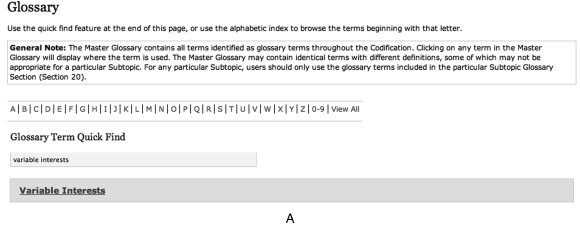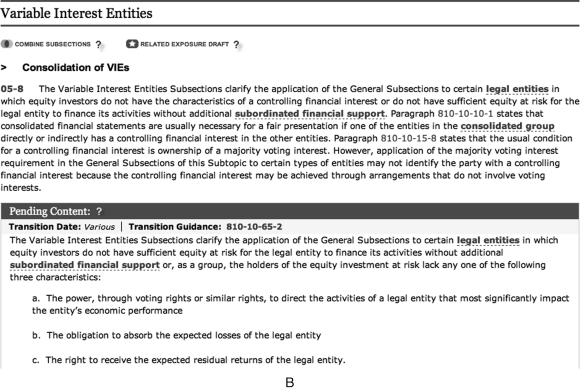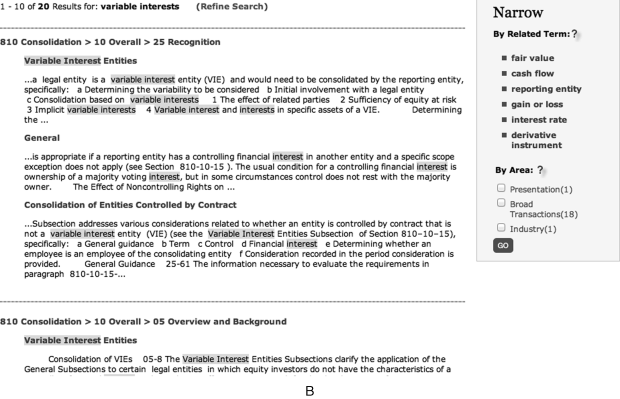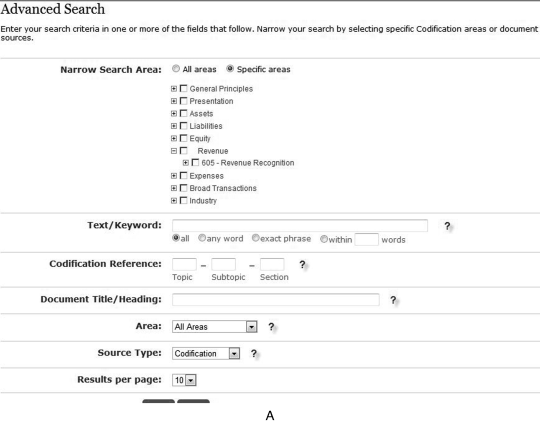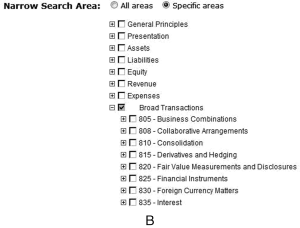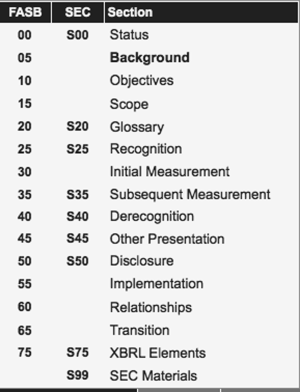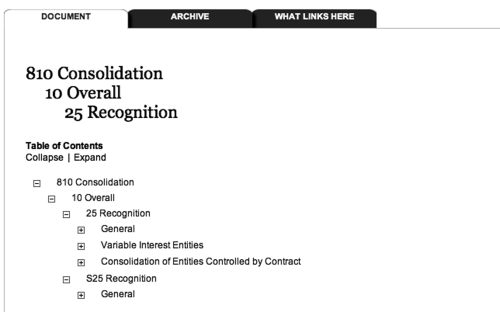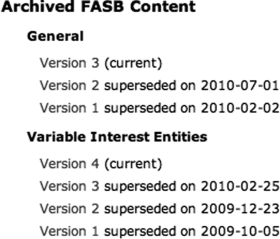The Research Process
The Codification database enables researchers to obtain authoritative evidence to help solve their research questions more efficiently than they could using manual hardbound tools. In addition to the cross-reference search discussed previously, search processes in the Codification include using the master glossary, performing a topical category search, and utilizing keyword search inquiries. The location of each search process is shown in the prior-referenced Exhibit 2-10, the Codification opening screen. The master glossary and topical categories options are located in the left navigation panel, and the search function is located in the top right screen area. Each search process is discussed in detail next. Note that the Codification may not contain guidance for the researcher's question, requiring the researcher to examine nonprimary support.
Master Glossary
The master glossary provides a list of all glossary terms contained in each topical category. To use the master glossary, left-click on the “Master Glossary” heading. As illustrated in Exhibit 2-14, the alphabet will appear in the center screen along with a glossary term quick-find option. Left-click the desired letter or type in a term in the “Quick Find” area. If a letter is clicked, scroll down to the area of interest and click on the term to display its definition. If a term is entered in the quick-find area, the center screen will display results of all definitions with the term of interest.
Example
Assume the researcher is interested in the definition of variable interests. How would the researcher find the definition using the quick-find option?
The researcher would left-click on the “Master Glossary” heading, at which point a glossary term quick-find option would appear. Type the term “variable” and such terms as “variable annuity,” “variable interest entity,” “variable interests,” and so on will appear in the center screen. As the researcher continues to type, the results will be narrowed to that demonstrated in Panel A of Exhibit 2-14. Click the desired term to display the definition as shown in Panel B of Exhibit 2-14. Once in the definition, left-click on the incoming links heading to produce the location of the term within the Codification (Exhibit 2-15).
Topical Categories
As previously mentioned, the topical categories (“Presentation,” “Assets,” “Liabilities,” “Equity,” “Revenue,” “Expenses,” “Broad Transactions,” and “Industry”) are always displayed in the left navigation panel. Because most researchers have an idea of which topic is of interest to them, this tends to be the favorite search method and thus is utilized more than the other search functions. To search within the topics, move the cursor over the category of interest to open the subtopic window (see Exhibit 2-16). Keep moving the cursor to the right to open new windows until reaching the final area of interest, at which point left-clicking will allow access to the desired information in the center screen.
Example
Assume the researcher is interested in how to consolidate variable interests. Where would he or she begin to search using the topical category method?
Consolidation is located in the Broad Transactions topic. As illustrated in Exhibit 2-16, highlight “Broad Transactions,” “Consolidation” (810). Since this topic is new to the researcher, the researcher might try clicking on “Overall.” Left-click subtopic 10 to display sections, as illustrated in Panel A of Exhibit 2-17. The researcher is interested in variable interests, so he or she would most likely left-click on section 05, “Overview and Background,” which contains information about variable interests. Once in section 05, the researcher scrolls down to paragraph 8 (ASC 810-10-05-8) as illustrated in Panel B of Exhibit 2-17 to examine consolidation criteria.
Keyword Search: Basic and Advanced
Basic
A keyword search utilizes the search bar appearing at the top right screen area of the database as illustrated in Panel A of Exhibit 2-18. Enter a single keyword or multiple keywords and left-click “Go.” The search results appear in the center screen with short excerpts under each heading as shown in Panel B of Exhibit 2-18. Left-click the desired heading to produce the related literature. Note that whenever the researcher uses the search button, a box to the right of the results helps narrow the search by related terms or by area.
Advanced
An advanced search option is located beneath the search bar. As illustrated in Panel A of Exhibit 2-19, this feature allows the search to be narrowed by search area (all areas or specific categories with topic/subtopic choices as shown with the revenue subtopic), keyword (all, any, exact, or within so many words), Codification reference, document/title heading, area (all areas or specific categories without topic/subtopic choices), source type (the Codification or other), and number of results to display. As with the simple search function, the search terms appear in the center screen with the suggested narrowing subtopics window to the right. Once a search is performed, the advanced search function reappears below the potential results. Panel B of Exhibit 2-19 displays the narrow search area function.
Moving within a Codification Search and Section Links
For all searches, use the back arrow in the browser to move back to the previous search. Alternatively, the researcher can click on the larger topical area, and the previous search results will display. For instance, a search on “goodwill” results in topic and subtopic 350-20 (“Intangibles—Goodwill and Other).” A further refinement results in section 05, “Overview and Background,” or 15, “Scope and Scope Exceptions.” A researcher who left-clicks section 05 and then wants to return to the previous search results could either left-click the back button in the browser or left-click subtopic 20 to list all sections related to “goodwill.”
Once in a section-related area, a box labeled “Section Links” appears at the bottom of the page. As illustrated in Exhibit 2-20, left-clicking on the “Section Links” heading will open up a drop-down menu that allows the researcher to quickly link to another section within the same subtopic.
The Section Tabs: “Document,” “Archive,” and “What Links Here”
Once in a section-related area (e.g., 810-10-25, “Consolidation,” “Overall,” “Recognition”), three tabs appear at the top of the center screen area: “Document,” “Archive,” and “What Links Here” (Exhibit 2-21). The document area is the default tab in the center screen area containing the table of contents, which can be collapsed or expanded.
The “Archive” tab contains links to the current and superseded literature related to the section. As demonstrated in Exhibit 2-22, the archived literature is organized by versions, with the highest version number linking to the most recent literature and the smallest version number (1) linking to the content in effect upon Codification adoption (July 1, 2009).
The “What Links Here” tab provides links to related Codification content. As demonstrated in Exhibit 2-23, Paragraph 25-2 links to seven content areas.

